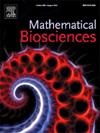On pattern formation in the thermodynamically-consistent variational Gray-Scott model
IF 1.8
4区 数学
Q2 BIOLOGY
引用次数: 0
Abstract
In this paper, we explore pattern formation in a four-species variational Gary-Scott model, which includes all reverse reactions and introduces a virtual species to describe the birth–death process in the classical Gray-Scott model. This modification transforms the classical Gray-Scott model into a thermodynamically consistent closed system. The classical two-species Gray-Scott model can be viewed as a subsystem of the variational model in the limiting case when the small parameter , related to the reaction rate of the reverse reactions, approaches zero. We numerically explore pattern formation in this physically more complete Gray-Scott model in one spatial dimension, using non-uniform steady states of the classical model as initial conditions. By decreasing , we observed that the stationary patterns in the classical Gray-Scott model can be stabilized as the transient states in the variational model for a significantly small . Additionally, the variational model admits oscillating and traveling-wave-like patterns for small . The persistent time of these patterns is on the order of . We also analyze the energy stability of two uniform steady states in the variational Gary-Scott model for fixed . Although both states are stable in a certain sense, the gradient flow type dynamics of the variational model exhibit a selection effect based on the initial conditions, with pattern formation occurring only if the initial condition does not converge to the boundary steady state, which corresponds to the trivial uniform steady state in the classical Gray-Scott model.
热一致变分Gray-Scott模式的模式形成
本文探讨了包含所有逆反应的四种变分Gary-Scott模型的模式形成,并引入了一个虚拟物种来描述经典Gray-Scott模型中的生灭过程。这种修正将经典的Gray-Scott模型转变为一个热力学一致的封闭系统。经典的两种Gray-Scott模型可以看作是变分模型的一个子系统,在极限情况下,与反反应的反应速率相关的小参数λ趋于零。我们使用经典模型的非均匀稳态作为初始条件,在一个空间维度上对这个物理上更完整的Gray-Scott模型中的模式形成进行了数值探索。通过减小λ,我们观察到经典Gray-Scott模型中的平稳模式可以稳定为变分模型中的瞬态,且λ值非常小。此外,变分模型允许小的λ振荡和行波模式。这些模式的持续时间约为O(ε−1)。我们还分析了固定ε的变分Gary-Scott模型中两个均匀稳态的能量稳定性。虽然两种状态在一定意义上都是稳定的,但变分模型的梯度流型动力学表现出基于初始条件的选择效应,只有当初始条件不收敛到边界稳态时才会出现模式形成,这对应于经典Gray-Scott模型中的平凡均匀稳态。
本文章由计算机程序翻译,如有差异,请以英文原文为准。
求助全文
约1分钟内获得全文
求助全文
来源期刊

Mathematical Biosciences
生物-生物学
CiteScore
7.50
自引率
2.30%
发文量
67
审稿时长
18 days
期刊介绍:
Mathematical Biosciences publishes work providing new concepts or new understanding of biological systems using mathematical models, or methodological articles likely to find application to multiple biological systems. Papers are expected to present a major research finding of broad significance for the biological sciences, or mathematical biology. Mathematical Biosciences welcomes original research articles, letters, reviews and perspectives.
 求助内容:
求助内容: 应助结果提醒方式:
应助结果提醒方式:


